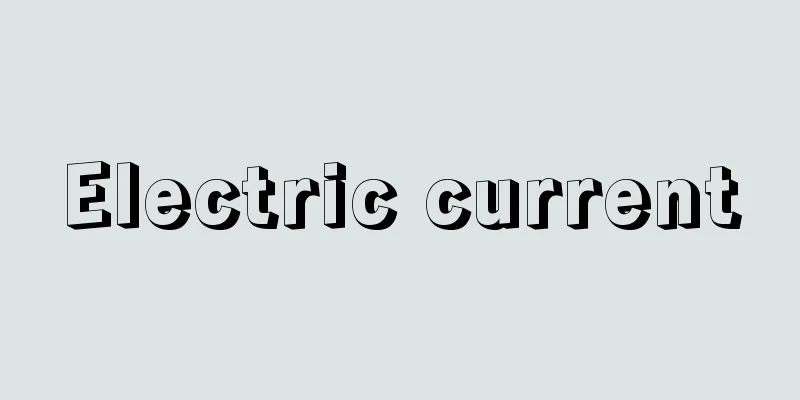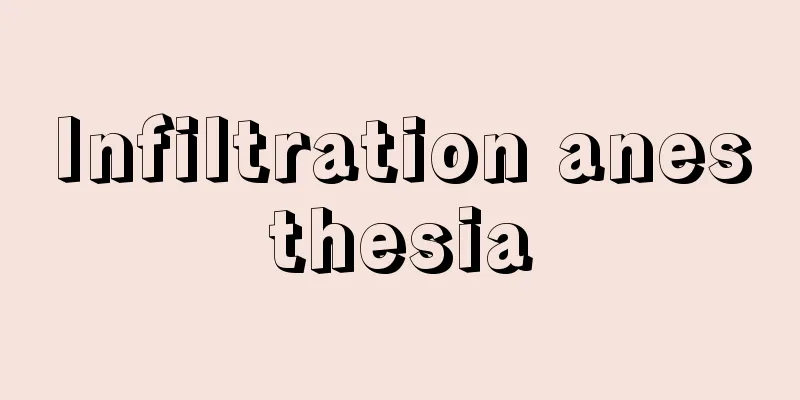Electric current

|
This usually refers to the phenomenon in which groups of electric charges move continuously. It is similar to the phenomenon in which groups of water molecules move continuously, which is called a water flow. The direction in which positive charges flow is defined as the direction of electric current. In most cases, the carrier of electric current is the electron, and since electrons are negatively charged, the direction of the electron movement is opposite to the direction of electric current. Electric currents are classified according to the mechanism by which they are produced: (1) The current that occurs when free electrons in a conductor or vacuum, such as a cathode ray tube, are forced to move by an electric field is called conduction current. (2) An electric current that occurs when a charged particle is forced to move by an electric field, such as the movement of ions in an electrolyte solution, is called a portable current or a transport current. (3) The electric current generated by orbital electrons, electron spins, or nuclear spins within an atom is called bound current. Electric current can be broadly divided into two types, depending on whether the direction of flow is constant or whether it changes over time. Current that flows in a constant direction, such as the current flowing from a battery, is called direct current, or simply DC, while current that flows in a cyclical manner, such as the electricity distributed to homes, is called alternating current, or simply AC. The above is a current generated by the movement of electric charges, but for example, when an AC voltage is applied to a capacitor, no charge flows between the plates of the capacitor, but the same magnetic effect is generated in the surrounding area as when a current flows between the plates. For this reason, it is more reasonable to think of a current flowing inside the capacitor. Current that is not caused by the movement of electric charges like this is called a displacement current. The most notable effects of electric current are magnetic, heat, and chemical. The magnetic effect of electric current refers to the phenomenon in which a magnetic field is generated around the electric current. The strength and direction of the magnetic effect of electric current are expressed by Biot-Savart's law. Furthermore, Ampere's law, which is derived from this law and includes the effect of displacement current, expresses all magnetic phenomena caused by electric current. Electromagnets utilize this effect. When there is electric current in a magnetic field, the current is subjected to a force from the magnetic field. This force is called the Lorentz force. Electric motors utilize this effect. The heat effect of electric current refers to the phenomenon in which heat is generated when electric current flows through a material. The heat generated in this way is called Joule heat. Joule's law holds that the amount of heat generated is proportional to the square of the strength of the current, the resistance, and the time the current flows. Electric heaters utilize this phenomenon. On the other hand, in electrical equipment and computers, the generation of this heat is not only a waste of power, but is also harmful to the operation of the equipment. The chemical action of electric current is the phenomenon in which, when electric current flows through a salt, acid or other aqueous solution, the components of the solute or substances resulting from secondary reactions are deposited on the electrodes. This is called electrolysis, and the relationship between the amount of substance deposited and the electric current is expressed by Faraday's law (of electrolysis). The unit of electric current is the ampere (A), which is defined as "a constant current that flows through two infinitely long linear conductors, each with an infinitesimally small circular cross section, placed in parallel in a vacuum and spaced 1 meter apart, exerting a force of 2 x 10-7 newtons on each meter of the length of the conductors." A current of 1 ampere carries 1 coulomb of charge per second. Since the strength of alternating current is constantly changing, the effective value, calculated as the square root of the average of the squares of the instantaneous values of the current, is used. [Madashi Fuse and Masazumi Yoshizawa] [References] | | | | |Source: Shogakukan Encyclopedia Nipponica About Encyclopedia Nipponica Information | Legend |
|
通常、電荷群が連続的に動く現象をいう。水の分子群が連続的に動く現象を水流とよぶのに似ている。正電荷の流れる向きを電流の向きと定めてある。電流の担体は多くの場合電子であり、電子は負電荷を帯びているから電子の動く向きと電流の向きとは反対になる。 電流はその生ずるメカニズムに従って次のように分類されている。 (1)導体内や真空中、たとえばブラウン管内の自由電子が電界によって力を受けて動くために生ずる電流を伝導電流という。 (2)電解質溶液中のイオンの運動のように、帯電した粒子が電界によって力を受けて動くために生ずる電流を携帯電流あるいは運搬電流という。 (3)原子内で軌道運動している電子や電子スピンあるいは核スピンによって生ずる電流を束縛電流という。 電流は流れる向きが一定しているか、時間とともに変わるかによって2種類に大別される。電池から流れ出る電流のように、向きが一定している電流を直流電流または単に直流といい、家庭などに配電されている電気のように、流れる向きが周期的に変わる電流を交流電流または単に交流という。 以上は電荷の運動によって生ずる電流であるが、たとえばコンデンサーに交流電圧が加えられた場合、コンデンサーの極板間には電荷の流れはないが、極板間に電流が流れているときと同じ磁気作用を周囲に生ずる。このことからコンデンサーの中には電流が流れていると考えるほうが合理的である。このように電荷の運動によらない電流を変位電流という。 電流の作用の著しいものに、磁気作用、発熱作用、化学作用がある。電流の磁気作用とは、電流の周囲に磁界が生ずる現象をいう。電流の磁気作用については、ビオ‐サバールの法則でその強さおよび向きが表されている。さらにこの法則から導き出されるアンペールの周回積分の法則に変位電流の効果を含めたアンペールの法則で、電流によって生ずる磁気現象のすべてが表されている。電磁石はこの作用を利用したものである。また磁界中に電流があるときは、電流は磁界から力を受ける。この力をローレンツ力とよんでいる。電動機はこの作用を利用したものである。電流の発熱作用とは、電流が物質中を流れるとき熱を発生する現象をいう。このようにして発生した熱をジュール熱とよんでいる。発生する熱量については、電流の強さの2乗と抵抗および電流が流れる時間に比例するというジュールの法則が成り立つ。この現象を利用したものが電熱器である。これに対し、電気機器やコンピュータなどでは、この熱の発生は電力の浪費となるだけでなく、機器の動作に対して有害である。電流の化学作用とは、電流が塩、酸その他の水溶液中を流れるときに、溶質の成分または二次反応の結果生ずる物質が電極に析出する現象をいう。これを電気分解とよんでおり、析出する物質の量と電流の関係はファラデーの(電気分解の)法則で表される。 電流の単位はアンペア(A)で、「真空中に1メートルの間隔で平行に置かれた無限に小さい円形断面を有する無限に長い2本の直線状導体のそれぞれを流れ、これらの導体の長さ1メートルごとに力の大きさが2×10-7ニュートンの力を及ぼし合う不変の電流を1アンペアとする」と定義してある。1アンペアの電流は1秒間に1クーロンの電荷を運ぶ。交流の場合は強さが絶えず変化するので、電流の瞬時値の2乗の平均の平方根をとった実効値を用いる。 [布施 正・吉澤昌純] [参照項目] | | | | |出典 小学館 日本大百科全書(ニッポニカ)日本大百科全書(ニッポニカ)について 情報 | 凡例 |
Recommend
Life Bullet - Life Ball
Also known by names such as Mamoridama and Yurushi...
Otsuki [town] - Otsuki
A town in Hata County, in the southwestern tip of ...
Camagüey (English spelling)
A city in central-eastern Cuba. It is located abou...
Sharqiya (English spelling)
…It borders the Mediterranean Sea to the north, L...
Príncipe, Ilha (English spelling)Principe Ilha
…Official name = Democratic Republic of São Tomé ...
Serveti-Funun (English spelling)
…Turkish author. He edited the magazine Serveti-F...
Water division - Bunsui
The former name of a town (Bunsui-machi) in Nishi...
Chinese (Pig) (English)
…In Japan before the war, it was the second most ...
Abdul Rashid Ali Shermarke
...In order to counter Ethiopia, which had receiv...
《Otokodate Hatsugaisoga》 - Otokodate Hatsugaisoga
...Afterwards, in "Ume Yubei Kawasekin"...
Euler's Function - My Function
…Among the cosets, the class consisting of intege...
Kashima (Ehime) - Kashima
…The Awai district in the southern part of the ci...
Agent Wholesalers (English)
… Wholesalers whose main business is wholesale ar...
Company Law - Kaishaho
The Significance of the Companies Act Law as a ru...
Racing competition - Kyousokyogi
…If the same athlete makes two false starts, he o...









